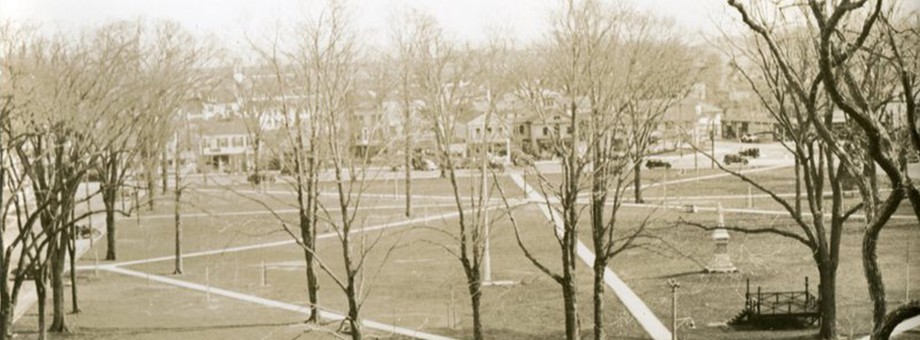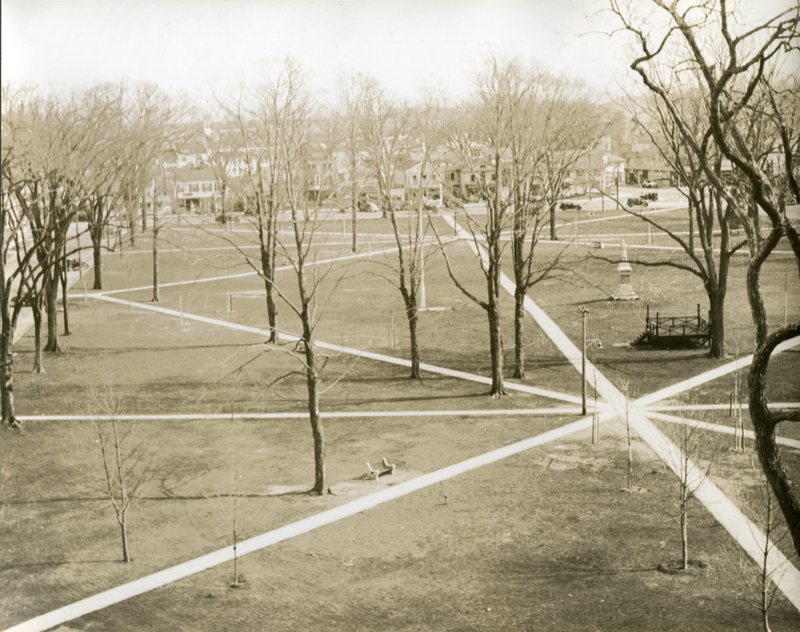THE GUILFORD GREEN—A WINDOW IN TIME

The Guilford Green lies at the center of the community’s nearly four centuries of history, and in many ways offers a window onto the passage of time here. The Green was established shortly after the community’s founding in 1639. From its earliest days, the community claimed the Green is its practical and symbolic heart.
The 16-acre Green served both as a source for necessary resources and as a tangible expression of civilizing a New World wilderness. The Green was the pasture for all manner of livestock and provided firewood and construction materials, especially lumber, gravel, and stone, for the many early homes and businesses that sprang up around it. The Green was also the center of religion, education, and governance. The sacred meetinghouse and graves were the first manmade elements placed upon it, eventually followed by four schools and the secular Townhouse. The Green was also the center of commerce. Blacksmiths, whose valuable skills were in high demand in young Guilford, were enticed to settle with pieces of the Green carved off for their benefit. In addition, the Green became a marketplace, and hay scales were built upon it. Geographically, socially, commercially, and symbolically, the Green was the center of Guilford.
As Guilford evolved, so did the Green. Around the turn of the 19th century—more than 150 years after the community’s establishment—town leaders decreed that all “encumberances” be removed. This process did not begin immediately, but by the 1830s the churches had moved off the Green, the remaining buildings were razed, trees were replanted, and fencing defined it. Although the Green had begun its transformation into today’s beautiful park, the Post Road still traversed it, cattle still grazed freely, and grass for hay grew tall upon it.
In the latter half of the 19th century, the Green continued its evolution from working space to recreational space. Skating, football, baseball, band concerts, and the town’s storied agricultural fair were among the many important pursuits that took place there. Moreover, the women of Guilford, through the United Workers for Public Improvement, embarked on a beautification project. They raised money for lights and sidewalks, replanted more trees, and—with much fanfare—raked the Green.
Shortly after the Civil War, the first of many monuments was placed upon the Green. The Green became the site of community memory, with walks, stones, benches, and flagpoles dedicated to honor the sacrifice and dedication of war dead, leaders, and loved ones.
Route 1 was rerouted in the 20th century, drawing commerce north along the new transportation corridor and completing the Green’s transformation to community park. What was once a symbol of civilization and progress in a New World wilderness had instead become a symbol of past serenity and natural beauty in a rapidly urbanizing Northeast.
The beautiful Green still anchors Guilford’s identity as a community. High school graduation is held upon the Green each spring, and the parade for the Guilford Fair circles it each fall. Cherished by residents and visitors alike, the Green remains Guilford’s heart after nearly four centuries of continuity and change.
